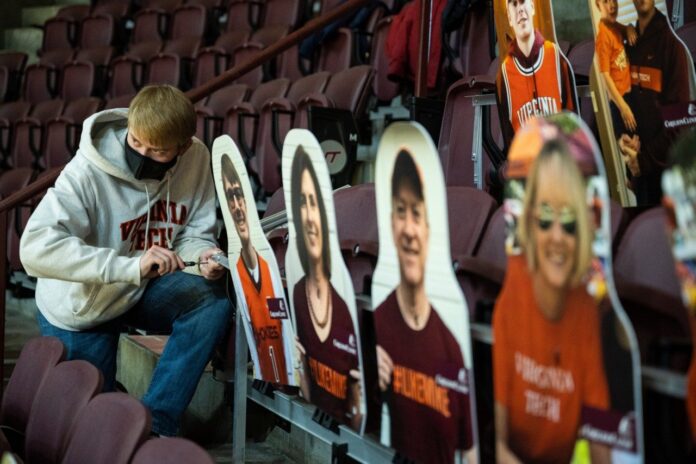When Syracuse University’s Kamilla Cardoso stepped up to the free throw line in the final 3 minutes 46 seconds of the Orange’s game against the Hokies in Cassell Coliseum last month, there was quite a bit of commotion from just behind the basket.
From the student section, Virginia Tech cheerleaders yelled through orange megaphones, maroon and orange skinny ballon characters waved all around, and eight rows of cardboard fan heads moved back and forth, like windshield wipers.
The 112 shifting cutout faces are a result of about five months of work by a group of seven Virginia Tech mechanical engineering students. They designed the cutouts to move using a motor, metal bars that link together, and two large batteries.
With limited spectators allowed at the university’s athletic events, including men’s and women’s basketball games, due to the coronavirus pandemic, the moving cutouts inject some new life into the student section. Basketball fans purchased the cardboard photos as donations to Virginia Tech Athletics.
“We wanted to imitate fans being there and moving around,” said Andrew Choi, a senior who is president of the American Society of Mechanical Engineers at Virginia Tech and leader of the project that the club took on in October. “The biggest thing for us was to support the school and support the teams to get a little bit more Hokie spirit inside.”
“Hopefully, they [opposing players] will miss a few more baskets and miss their free throws,” Choi said.
It may have worked for some games. For instance, on Feb. 27, Wake Forest University’s men’s basketball team made only six free throws out of 13 attempts during the game at Cassell Coliseum.
No matter how successful the moving cutouts are at distracting opposing players, Virginia Tech Athletics was excited when the students contacted them with the project.
“When we are able to collaborate with campus groups, that’s a win for everybody,” said Bob Gavagan, associate director of marketing and fan experience for VT Athletics.
The concept to design moving cutouts actually came from a Virginia Tech alumnus who emailed Choi with the idea.
“It sounded like the coolest idea to me,” said Molly Maranto, a junior and one of the ASME members who helped build the device.
Choi, Maranto, and five other ASME student members designed the prototype and rented space at Hacksburg, a community makerspace workshop located in the Virginia Tech Corporate Research Center, where they did most of the project labor. They could not work in a campus lab, due to COVID-19 restrictions.
Choi said he used some ideas that he gleaned from a dynamics of machinery class to inform the device’s design. The students used four metal bars that link together and on which the cutouts move, and they attached a crank arm to each row.
“It’s definitely nice to be able to take something out of the classroom and apply it to real life,” Choi said. “You get to learn a lot more along the way than simply reading it from a book.”
Two batteries power the eight rows of moving cutouts through the second half of the game.
The students visited Cassell Coliseum several times to install the cutouts. The first three rows of moving cutouts debuted during a Virginia Tech men’s basketball game against the University of Virginia on Jan. 30, and ESPN included a quick video of the action on its live broadcast.
A few mechanical engineering student volunteers are attending the remaining Hokie home games in order to turn on the moving cutouts and monitor them.
Seeing the work come together has been rewarding for the ASME students, who plan to count the moving cutouts as the club’s annual design project.
“Hopefully by this, we can increase the spirit of people who are not in the coliseum right now,” said Pratik Satija, a junior at Virginia Tech and vice president of ASME.
By Jenny Kincaid Boone

